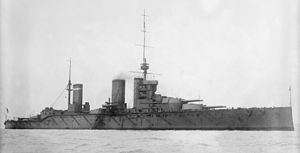 Princess Royal at anchor, before 1916
| |
| Class overview | |
|---|---|
| Builders | |
| Operators | |
| Preceded by | Indefatigable class |
| Succeeded by | Queen Mary |
| Built | 1909–1912 |
| In commission | 1912–1920 |
| Completed | 2 |
| Scrapped | 2 |
| General characteristics (as built) | |
| Type | Battlecruiser |
| Displacement | 26,270 long tons (26,690 t) (normal) |
| Length | 700 ft (213.4 m) |
| Beam | 88 ft 6.75 in (27 m) |
| Draught | 32 ft 5 in (9.9 m) (deep load) |
| Installed power |
|
| Propulsion | 4 × shafts; 2 × steam turbine sets |
| Speed | 27.5 knots (50.9 km/h; 31.6 mph) |
| Range | 5,610 nmi (10,390 km; 6,460 mi) at 10 knots (19 km/h; 12 mph) |
| Complement | 1,092 |
| Armament |
|
| Armour | |
The Lion class were a pair of battlecruisers built for the Royal Navy before World War I. Nicknamed the "Splendid Cats",[1] the ships were a significant improvement over their predecessors of the Indefatigable class in speed, armament and armour. These improvements were in response to the German battlecruisers of the Moltke class, which were in turn larger and more powerful than the first British battlecruisers of the Invincible class.
Lion served as the flagship of the Grand Fleet's battlecruisers throughout World War I.[2] She sank the German light cruiser Cöln during the Battle of Heligoland Bight in August 1914 and participated in the battles of Dogger Bank in 1915 and Jutland the following year. She was so badly damaged at the Battle of Dogger Bank that she had to be towed back to port. During the Battle of Jutland, Lion suffered a serious cordite fire that could have destroyed the ship.
Her sister ship, Princess Royal, also played a role in the Battle of Heligoland Bight, and was then sent south to the Caribbean to intercept the German East Asia Squadron in case they used the Panama Canal. After the squadron was sunk at the Battle of the Falkland Islands in December 1914, Princess Royal rejoined the 1st Battlecruiser Squadron (BCS). During the Battle of Dogger Bank, she scored only a few hits, but one crippled the German armoured cruiser Blücher, which allowed the enemy vessel to be caught and sunk by the concentrated fire of the British battlecruisers. Shortly afterwards, Princess Royal became the flagship of the 1st BCS and participated in the Battle of Jutland. Both ships were present during the inconclusive Action of 19 August 1916.
The sisters spent the rest of the war on uneventful patrols in the North Sea; they provided distant cover during the Second Battle of Heligoland Bight in 1917. In 1920, they were put into reserve and were then sold for scrap a few years later in accordance with the terms of the Washington Naval Treaty of 1922.